
RFA Broomdale (A168) was a Dale-class fleet tanker of the Royal Fleet Auxiliary. She spent much of her career in the Indian Ocean and Far East.

The Svetlana-class cruiser was the first class of light cruisers built for the Imperial Russian Navy (IRN) during the 1910s. Construction was interrupted by World War I, the Russian Revolution and the Russian Civil War. Only Svetlana of the quartet was completed by the Soviet Union as a cruiser, two were converted to oil tankers, and the remaining ship was scrapped without being completed.

The Japanese aircraft carrier Taiyō was the lead ship of her class of three escort carriers. She was originally built as Kasuga Maru (春日丸), the last of three Nitta Maru class of passenger-cargo liners built in Japan during the late 1930s for NYK Line. The ship was requisitioned by the Imperial Japanese Navy (IJN) in early 1941 and was converted into an escort carrier. Taiyō was initially used to transport aircraft to distant air bases and for training, but was later used to escort convoys of merchant ships between Japan and Singapore. The ship was torpedoed twice by American submarines with negligible to moderate damage before she was sunk in mid-1944 with heavy loss of life.
SM U-83 was a Type U 81 U-boat of the German Imperial Navy during the First World War. She had been commissioned and deployed to operate off the coast of the British Isles and attack coastal shipping as part of the German U-boat campaign.
HMS Hilary was a Booth Line passenger steamship that was built in Scotland in 1908 and operated scheduled services between Liverpool and Brazil until 1914. In the First World War she was an armed merchant cruiser (AMC) until a U-boat sank her in the Atlantic Ocean in 1917.
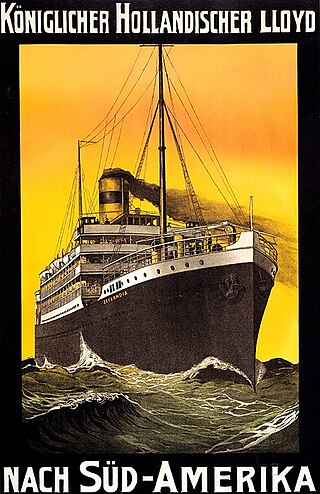
USS Zeelandia was an ocean liner that was built in Scotland in 1910 and scrapped in the Netherlands in 1936. She was the largest ship in the Koninklijke Hollandsche Lloyd (KHL) fleet from 1910 until the liners Gelria and Tubantia were completed in 1913 and 1914. She was USS Zeelandia from April 1918 until October 1919, when she was a United States Navy troopship.
MV Dumana was a British cargo liner that was laid down as Melma, but launched in 1921 as Dumana. The British India Steam Navigation Company (BI) owned her, and ran her on routes between London and India.
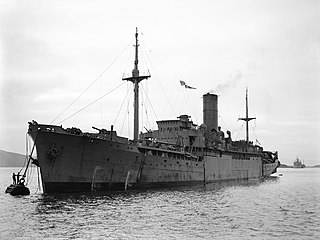
HMS Agamemnon was originally the Blue Funnel Line refrigerated cargo ship Agamemnon. She was built in 1929, traded between the UK and the Far East, and was scrapped in 1963. During the Second World War she was converted into an auxiliary minelayer in 1940, and then into an amenities ship in 1943.
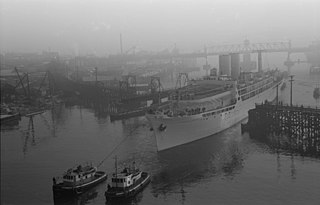
HMS Menestheus was originally the Blue Funnel Line refrigerated cargo ship Menestheus. She was built in 1929, and traded between the UK and the Far East. She was an auxiliary minelayer from 1940 to 1943. In 1945, during the Second World War, she was converted into an amenities ship. She was scrapped in 1953 after being gutted by fire.
Takao Maru (高雄丸) was an OSK Line cargo and passenger steamship that was built in Japan in 1927. In 1941 the Imperial Japanese Army requisitioned her. US aircraft damaged her during the first week of the Japanese invasion of the Philippines. In 1942 she was declared a total loss.
MS Gruziya was one of six Soviet Krim-class ocean liners during the late 1920s built for the Black Sea State Shipping Company. During the Second World War, she participated in the Siege of Odessa in 1941 and the Siege of Sevastopol in 1942. The ship was sunk by a German bomber en route to the latter port in June; there were no survivors.

SS Grampian was a transatlantic ocean liner that was built in Scotland in 1907 and scrapped in the Netherlands in 1925. She was operated originally by Allan Line, and later by Canadian Pacific Steamships. In the First World War she remained in commercial service but carried Canadian troops. In 1919 she survived a collision with an iceberg. In 1921 she was gutted by fire while being refitted. The refit was abandoned, and in 1925–26 she was scrapped.

SS Rio Tercero was a cargo steamship that was launched in England in 1912 as Eboe. She was renamed Fortunstella in 1938, and Rio Tercero in 1941. A U-boat sank her in the Battle of the Atlantic in 1942.
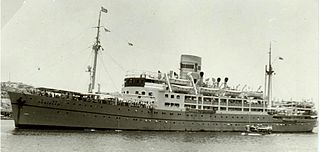
Jagiełło was a medium-sized passenger-cargo ship, sailing under the Polish flag between 1948 and 1949, and then decommissioned due to unprofitable and post-war political conditions, which were not conducive to the development of the Polish passenger fleet, and then transferred to the Soviet Union as Pyotr Velikiy, operating Black Sea passenger services until 1973. The ship had been built by Blohm & Voss for Turkish operators, taken over after completion by the German government. After World War 2 it taken over by the British and then the Soviet Government.
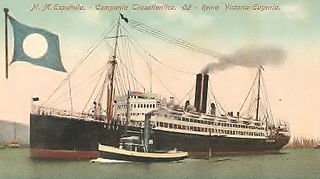
SS Reina Victoria-Eugenia was a steam ocean liner and mail ship launched in 1912 in England and operated by the Compañía Transatlántica Española (CTE). She and her sister ship Infanta Isabel de Borbon represented a significant modernisation of CTE's fleet of ageing and obsolescent ships.
The Krim-class ocean liners consisted of six ships built during the late 1920s for service in the Black Sea. The first two ships were built in Germany, but the rest were built in the Soviet Union. Four ships were sunk during the Second World War, while the other two survived the war.
MS Abkhazia was one of six Soviet Krim-class cargo liners during the late 1920s built for the Black Sea State Shipping Company. During the Second World War, she participated in the Siege of Odessa in 1941 and the Siege of Sevastopol in 1942. She was sunk by German aircraft in the port in June.
MS Adzharistan was one of six Soviet Krim-class cargo liners built for the Black Sea State Shipping Company during the late 1920s. The first pair were built in Weimar Germany, but the other four, including Adzharistan, were built in the Soviet Union and varied slightly from the German-built ships. A month after the invasion of the Soviet Union by the Axis powers in June 1941, she was destroyed by German aircraft.
MS Ukraina was one of six Soviet Krim-class ocean liners during the late 1920s built for the Black Sea State Shipping Company. During the Second World War, she participated in the Siege of Odessa in 1941 and the Siege of Sevastopol in 1942. She was sunk by German aircraft in July.
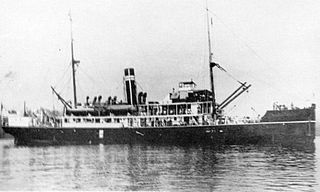
SS Sir Harvey Adamson was a coastal passenger steamship that was built in Scotland in 1914 for the British India Steam Navigation Company (BI). She traded along the coast of Burma until 1947, shen she disappeared in a gale in the Andaman Sea. No survivor or identifiable wreckage was ever found.










